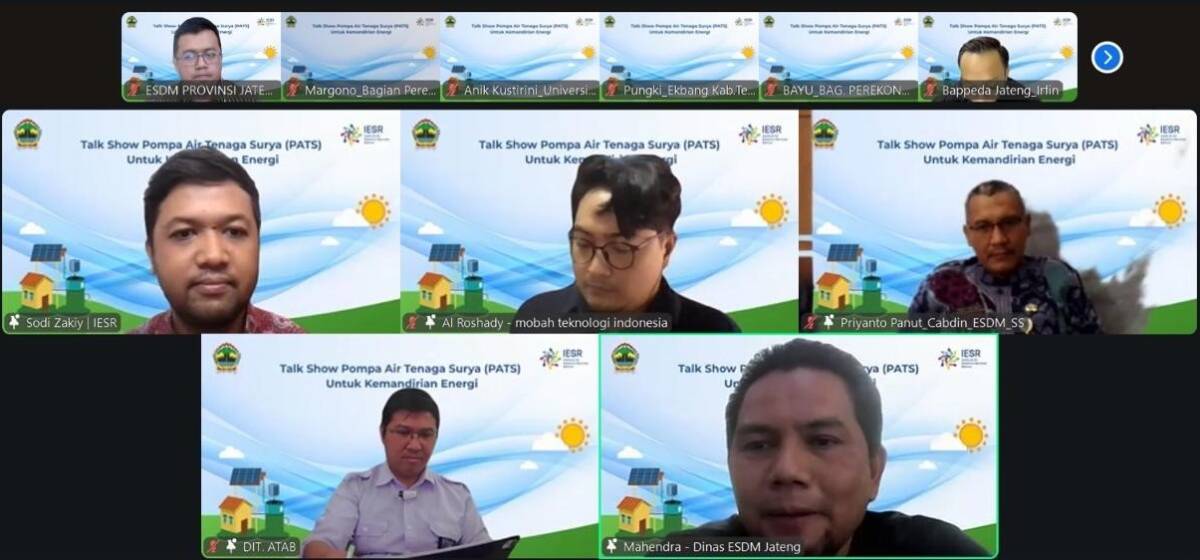Semarang, October 30, 2025 – The agricultural sector is one of the main pillars in achieving food security in Indonesia. As an agricultural country, Indonesia has great potential to develop a sustainable agricultural system. However, farmers still frequently face challenges in water availability and access. This often happened in rain-fed areas due to limited irrigation infrastructure, drought, and other environmental factors.
In response, Sodi Zakiy, Geographic Information Systems Analyst at the Institute for Essential Services Reform (IESR), explained that the implementation of Solar-Powered Water Pumps (PATS) is a technological innovation capable of increasing the efficiency of agricultural irrigation systems.
“Through PATS, farmers can access irrigation water more easily and sustainably without being burdened by high operational costs,” said Sodi while moderating the “Sharing Knowledge on PATS Implementation in Central Java” event organized by IESR in collaboration with the Central Java Provincial Energy and Mineral Resources (ESDM) Office.
Sodi also added that the use of PATS as an effort to promote energy independence at the sub-national level, as well as a concrete step to support the energy transition in the agricultural sector.
As an example of implementation, Priyanto Panut, Head of the South Serayu Energy and Mineral Resources Agency Branch Office, revealed that the PATS, built in 2022 in Krandegan Village, Purworejo Regency, Central Java, has successfully reduced operational costs by up to 30 percent compared to using diesel-fueled pumps.
“Of a total land area of approximately 62 hectares with an irrigation water requirement of 6,002 m³ per day, the PATS is able to irrigate approximately 35 hectares, equivalent to 30 percent of the total water requirement, with a supply capacity of 1,860 m³ per day,” Panut explained.
He added that the PATS system uses 57 monocrystalline photovoltaic modules with a capacity of 330 Wp per unit for a total power output of 18.8 kWp, integrated with pump control and a maximum power regulator. Furthermore, the pump used is a surface pump with an 11 kW three-phase AC motor, a maximum head of 12 meters, and a flow rate of up to 279 m³ per hour through a 6-inch diameter pipe.
During six months of operation, the PATS saved approximately Rp 21 million in fuel costs, equivalent to a daily expenditure of Rp 117,300. Meanwhile, the village government used the remaining 7 kWp of power to add two small 3 kW pumps, funded by village funds, and integrated with the PLN electricity grid through an on-grid system.
However, Diah Ayu Ratnasari, Head of the New and Renewable Energy (EBT) Division at the Central Java Provincial Office of Energy and Mineral Resources, explained that the implementation of the PATS still faced several obstacles, particularly in the permitting process for river water utilization, which involved multiple stakeholders.
“The PATS development process requires cross-sector coordination and the completion of technical documents, which often takes longer than the regional budget cycle, risking delays in physical construction. Furthermore, limited public information regarding permit requirements is also a challenge, as many regional project implementers do not understand the document requirements from the planning stage,” said Ayu.
Meanwhile, Pulung Arya Pranintya from the Directorate General of Water Resources at the Ministry of Public Works emphasized that the water use permit process aims to maintain the stability and availability of water, both surface and groundwater, so that its distribution remains equitable from upstream to downstream.
“This permit is not intended to make it difficult for farmers to access water, but rather to ensure equitable water availability from upstream to downstream,” Pulung explained.
He added that in practice, water management authority is hierarchical. The national government regulates river basins across provinces, provincial governments regulate those across districts or cities, while district/city governments are responsible for management within their respective administrative areas.
Pulung also added that the key to expediting permit processing is the applicant’s complete technical documents. He explained that if the documents are complete and the permit has not been issued within three weeks, the permit will be automatically granted.
From a technical perspective, Muhammad Al-Roshady, Founder of PT Mobah Teknologi Indonesia, shared his experience in developing PATS in various regions.
“We have developed four types of PATS systems tailored to land characteristics and user needs: direct solar pumping system, battery storage system, hybrid system (connected to the PLN grid), and portable system for smallholder farmers with scattered plots of land. Each type is designed to be efficient and easy to maintain. For areas requiring a constant water flow, a battery-free system is more efficient because it directly utilizes solar energy during the day. Meanwhile, for horticulture, which requires high water pressure or nighttime irrigation, a battery-powered system is a more flexible solution,” explained Roshady.
He also emphasized the importance of a social approach in implementing renewable energy projects in the grassroot to ensure community acceptance. PT Mobah Teknologi Indonesia involves local vocational schools (SMK) for training and maintenance of the PATS system. By involving local workers, the community becomes more open and have trust because the project is run by local people.

